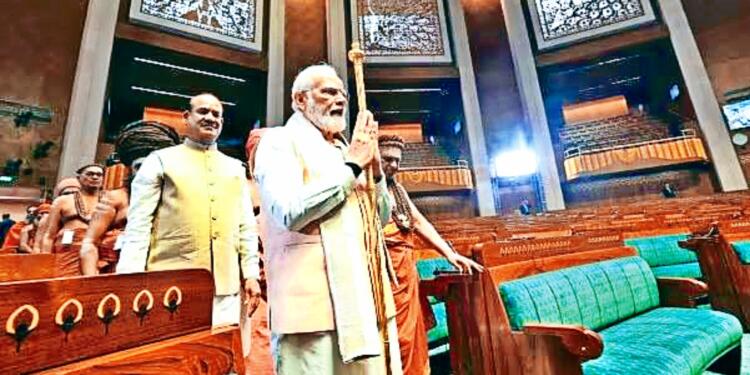The sengol, a historic scepter, has become the center of a heated debate in Indian politics. This traditional symbol, originally presented to India’s first Prime Minister Jawaharlal Nehru during the transfer of power from British rule, now stands prominently in the Lok Sabha. The sengol represents a rich cultural heritage, symbolizing the transfer of authority and governance. However, its presence in the heart of India’s democratic institution has sparked controversy among various political parties.
It is not new in Indian politics for Indian culture to be disrespected just for political gain and to satisfy political agendas. The illogical statements by the opposition reflect immaturity, insensitivity, and disrespect towards Indian culture.
Samajwadi Party’s Stance on the Sengol
Samajwadi Party MP RK Chaudhary has stirred the pot by calling for the removal of the sengol from Parliament. He argues that this symbol of monarchy is out of place in a democratic India. Chaudhary’s letter to the pro-tem Speaker Bhartruhari Mahtab described the sengol as an “anachronistic symbol of monarchy” in a country that prides itself on its democratic values. He suggests replacing the sengol with the Constitution, viewing it as more fitting for the nation’s governance in the modern era.
The Sengol’s Meaning and Chaudhary’s Rationale
Chaudhary elaborated on his stance, explaining that “Sengol” translates to “Raj Dand” or “Raja ka Danda” – essentially, the king’s scepter. He questioned whether a democratic nation should be governed by a royal symbol or by its Constitution. This argument has ignited a fierce debate about the role of historical symbols in contemporary governance.
BJP’s Defense of the Sengol
The Bharatiya Janata Party (BJP) strongly opposes the idea of removing the sengol. They see it as an integral part of Indian and Tamil culture, deeply rooted in the nation’s history. BJP spokesperson Shehzad Poonawalla responded to Chaudhary’s comments by questioning the logic behind his argument. Poonawalla pointed out that if the sengol truly represented monarchy, why did Nehru, a staunch democrat, accept it during the transfer of power?
The Sengol Debate Intensifies
Other political figures have joined the fray, turning the sengol into a hot-button issue. Akhilesh Yadav, Samajwadi Party chief, defended Chaudhary’s remarks. He pointed out that Prime Minister Narendra Modi didn’t bow to the sengol after taking his oath in the Lok Sabha, suggesting a possible inconsistency in the reverence shown to the symbol.
Meanwhile, RJD MP Misa Bharti suggested a compromise, proposing that the sengol be moved to a museum. This idea aims to preserve the sengol’s historical significance while addressing concerns about its place in a democratic institution.
Sengol: A Symbol of Tamil Culture?
The controversy has also touched on cultural sensitivities, particularly regarding Tamil heritage. Congress leader Renuka Chowdhury criticized the BJP’s understanding of South Indian culture. She argued that Tamil culture extends far beyond the sengol and that Tamilians should have been consulted before its installation in Parliament.
Government’s Strong Defense of the Sengol
Uttar Pradesh Chief Minister Yogi Adityanath strongly defended the sengol’s place in Parliament. He accused the Samajwadi Party of disrespecting Indian history and culture, framing the debate as a matter of national pride. Adityanath’s comments underscore the emotional and cultural weight attached to the sengol by its supporters.
Additionally, L Murugan, Minister of State for Parliamentary Affairs and former president of the Tamil Nadu BJP, highlighted the sengol’s importance in Tamil literature and history. He cited references to the sengol in Tirukkural, a classic Tamil text, emphasizing its deep roots in Tamil culture and governance traditions.
The Sengol’s Future in Parliament
As the debate rages on, the sengol remains a powerful symbol at the heart of Indian politics. Its presence in the Lok Sabha continues to spark discussions about tradition, democracy, and cultural representation in modern India. The controversy raises important questions about how a diverse nation like India should balance its rich historical heritage with its commitment to democratic principles.
Broader Implications of the Sengol Debate
The sengol controversy reflects deeper tensions in Indian politics. It touches on fundamental questions about national identity, the role of symbols in governance, and the relationship between tradition and modernity. As India continues to navigate its path as the world’s largest democracy, debates like this highlight the ongoing process of defining and redefining what it means to be Indian in the 21st century.
In conclusion, the sengol controversy is more than just a disagreement over a historical artifact. It represents a broader dialogue about India’s past, present, and future. As the debate unfolds, it’s clear that the sengol will continue to be a topic of discussion in India’s political landscape, serving as a focal point for conversations about culture, democracy, and national identity.
ALSO READ: “Na na karte pyar tumhi se…”: Uddhav Thackeray’s reaction for……?































